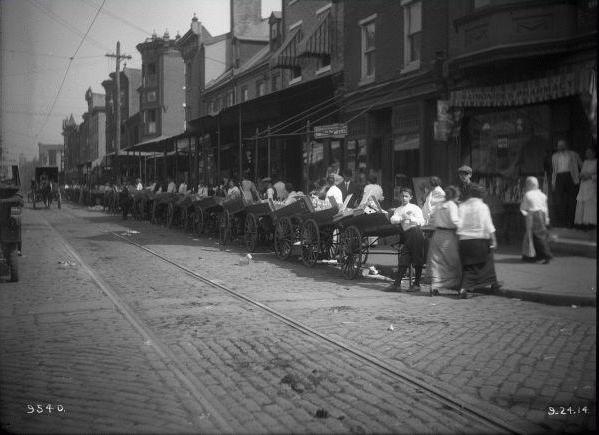
The Fleisher Years Chapter 2: The Expansion of the Graphic Sketch Club
Before Fleisher Art Memorial, there was the Graphic Sketch Club.
It was in the Jewish Union building at 422 Bainbridge Street— the center of the then-bustling Jewish Quarter of Philadelphia— that, Samuel Fleisher began holding art classes for kids in the neighborhood, many of whom were the children of factory workers. In 1898, this became known as the Graphic Sketch Club – an inviting, collaborative, and nondiscriminatory creative space. The laid-back style of the classes at the Graphic Sketch Club soon encouraged children and adults alike to experience and enjoy the process of art-making.
By 1906, the Graphic Sketch Club had become so popular that it moved to a new location at 740 Catharine to meet the growing demand for classes. Ten years later, Fleisher acquired the larger building across the street—the former Saint Martin’s College for Indigent Boys—followed by his acquisition of the adjacent Episcopal Church of the Evangelist in 1922.
Aptly named the Sanctuary, this space was intended to be a place of calm for those seeking opportunities for contemplation and reflection. The Sanctuary also housed Fleisher’s private collection of paintings and sculptures, which he made accessible for the public to study and draw inspiration from. Students were also invited to concerts and recitals, and they even had access to a Steinway baby -grand piano. Unlike other institutions and museums at the time, the Graphic Sketch Club was open in the evening, with working people in mind. Classes were offered to people of all ages in mediums ranging from drawing and painting to sculpture and even dancing.
Fleisher was dubbed “Philadelphia’s First Citizen” by the Brooklyn Eagle after winning the 1923 Philadelphia Award – created by Edward Bok to honor a Philadelphian “who has acted and served on behalf of the best interests of the community.” Fleisher gave “every cent” of the $10,000 prize money to bolstering the mission of increasing access to art and artmaking on which he created the Graphic Sketch Club. This award brought Fleisher into the national spotlight – garnering attention from The New York Times, who called the Graphic Sketch Club a ”Haven of the Humanities.”
About the importance of the Club and its goal, Fleisher said, “I thought, why not give [people] the chance to see these things of culture, of beauty, and of inspiration in their own neighborhood and in the congenial atmosphere of a place of recreation, rather than in some cold and formal mausoleum of art, even though museums are a recognized necessity?”
Over the years, the Graphic Sketch Club grew into an essential part of the neighborhood, serving as a pathway for artists to meet, learn, and exhibit their work. Annual student exhibitions at the Philadelphia club were highly praised, as read in a New York Times review of the 1929 exhibition: “The present show, which is regarded as the most colorful and satisfying in this history of the school, includes the work of artists who have been represented at some of the leading exhibitions in the country. One of the canvases which is attracting attention, entitled ‘Oakview,’ is a Winter landscape by Antonio Martino, who was a student at the Graphic Sketch Club twelve years ago.”
This tradition of the annual student exhibition continues to this day, as we celebrate the 124th Annual Student Exhibition this year.
Image credit: “Curbstone Market – 4th and Fitzwater Streets,” 1924, Courtesy of phillyhistory.org, a Project of the Philadelphia Department of Records.


To get updates on events, exhibitions & class information:
"*" indicates required fields